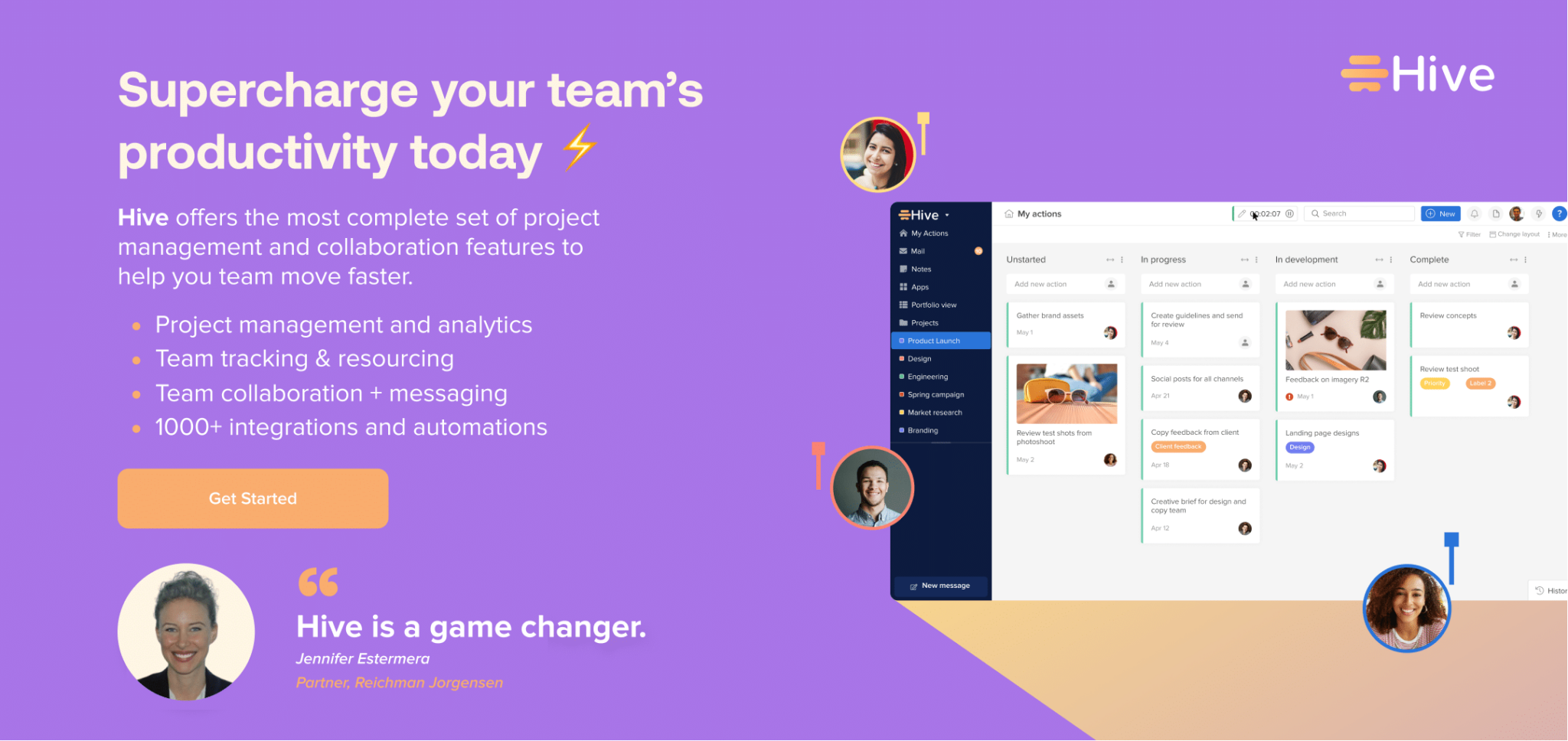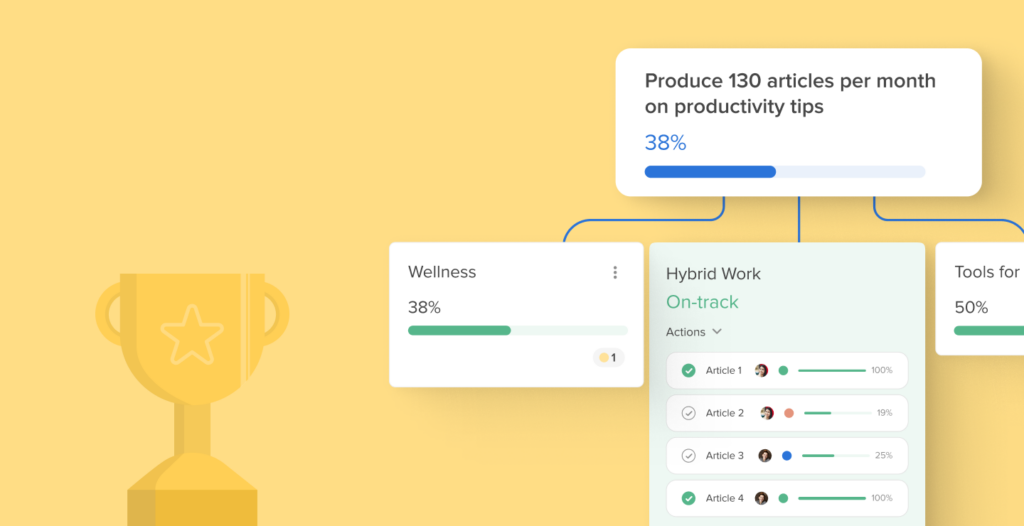
How a Content Team Uses Hive’s Goals Feature To Reach Theirs
If you’re running a content team, we know just how hard it can be to stay on top of deadlines, create content calendars, keep every team member on the path to success, and on top of it all, make sure all of your content marketing goals are prioritized. That’s why we’ve built a solution to ensure content teams can truly thrive: Hive’s Goals.
And with this new, exciting feature launch, you’ll have the opportunity to truly succeed in your goal-setting and tracking capabilities. Hive Goals, an app that allows you to connect with other projects, tasks and even import data from other sources, makes it easy to stay on top of every goal for yourself, your team and even the entire organization.
Take, for example, one of our newest Hive customers: Melanie, a content marketing manager at a large tech start-up. In the past, she has had a hard time staying on top of her workload while also managing her content team. In her role, it’s her job to make sure that every piece of content packs a punch — while also aligning with the team’s overall goals.
“When it comes to my day-to-day work, I find that important pieces of the content puzzle can sometimes fall through the cracks. And with so many projects and shifting priorities in start-up life, my team and I sometimes lose focus of what we should be working toward,” she shares.
With the help of Hive’s Goals feature, Melanie and her team can now not only keep track of their larger goals but also tick off each smaller piece of the puzzle as they go. Take a page from Melanie’s book on how her content team uses Hive Goals, below.
How a content team can succeed using Hive’s Goals
Like many content teams, Melanie’s team is focused on creating high-impact, quality content that captivates readers. Above all, that’s their biggest goal. And what content team doesn’t want that, right? No matter if you’re looking to drive revenue through your content, up your B2B sales or capture new emails for your content newsletter, Hive Goals will be the backbone of your goals-setting and tracking.
But with such a large and often ambiguous goal, it doesn’t always seem attainable. Anyone who works in the tech space knows that things can change in a second, so it can be unclear how to pivot or even begin on a new initiative . That’s where Hive Goals comes in, helping Melanie’s team skip the overwhelm and jump into confident teamwork. Using Hive’s Goals, Melanie was able to break down this significant goal into much smaller, bite-sized goals — making each step seem easily digestible, trackable, and best of all, achievable.
How this tech start-up broke down their content goals
1. Distribute content on the blog weekly

First things first: Melanie wanted her content team to distribute weekly content on their blog about productivity in the workplace. Every piece of content needed to fall into three different separate categories: Hybrid Work, Wellness and Tools For The Workplace. This is an easy structure to tackle using Hive’s Goals. Let’s break this down into a comprehensive Goal “tree.”
Overall Goal: Produce 130 articles per month on productivity tips
There are different ways to approach this, but first, Melanie created a ‘parent goal’ — a larger goal for the team to work towards. Having a parent goal is important for the overall direction of your content team — without one, your team members could feel lost.
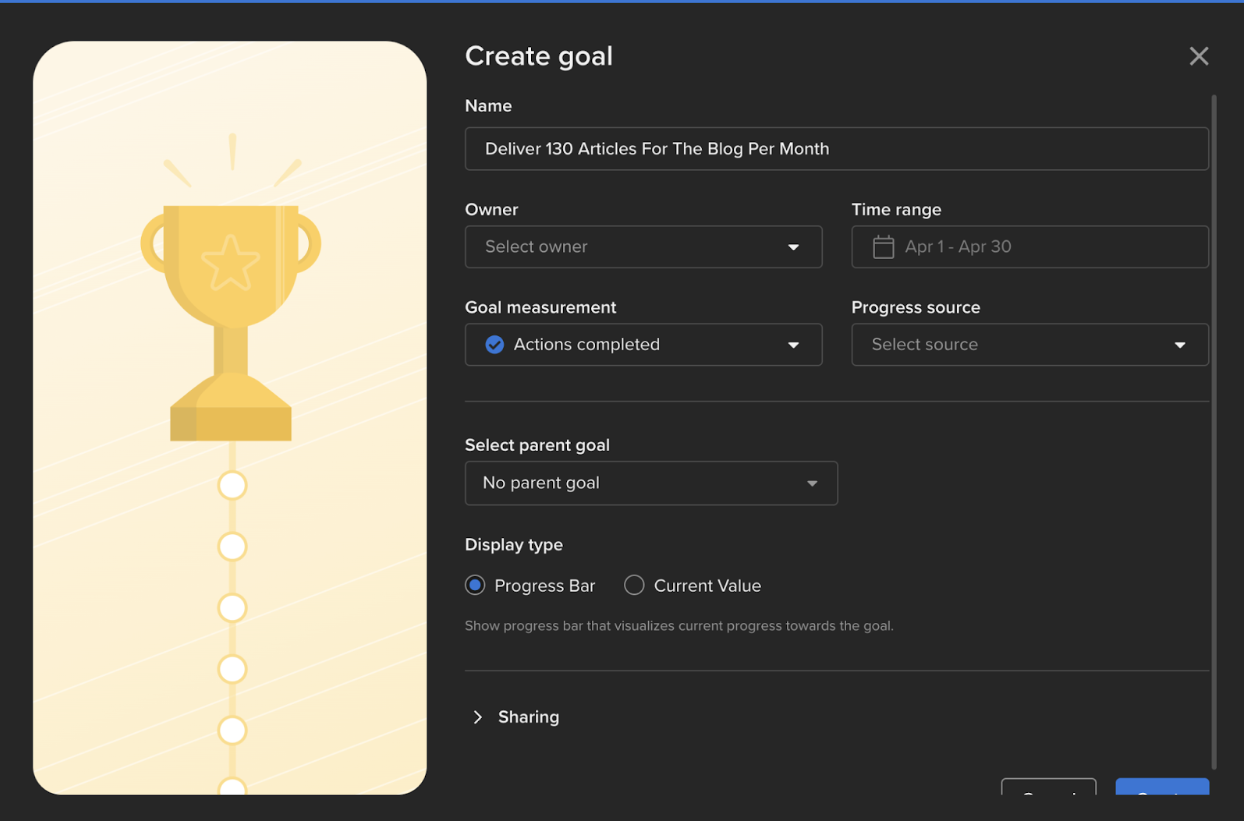
Then, she created subgoals, which are smaller goals that complete the parent goal. She decided to divide her subgoals into the different types of content categories she wants her team to focus on.
Subgoals: Create three subgoals titled Hybrid Work, Wellness and Tools For The Workplace. These subgoals will be clickable from the parent goal as well, if you’d like to access them quickly.
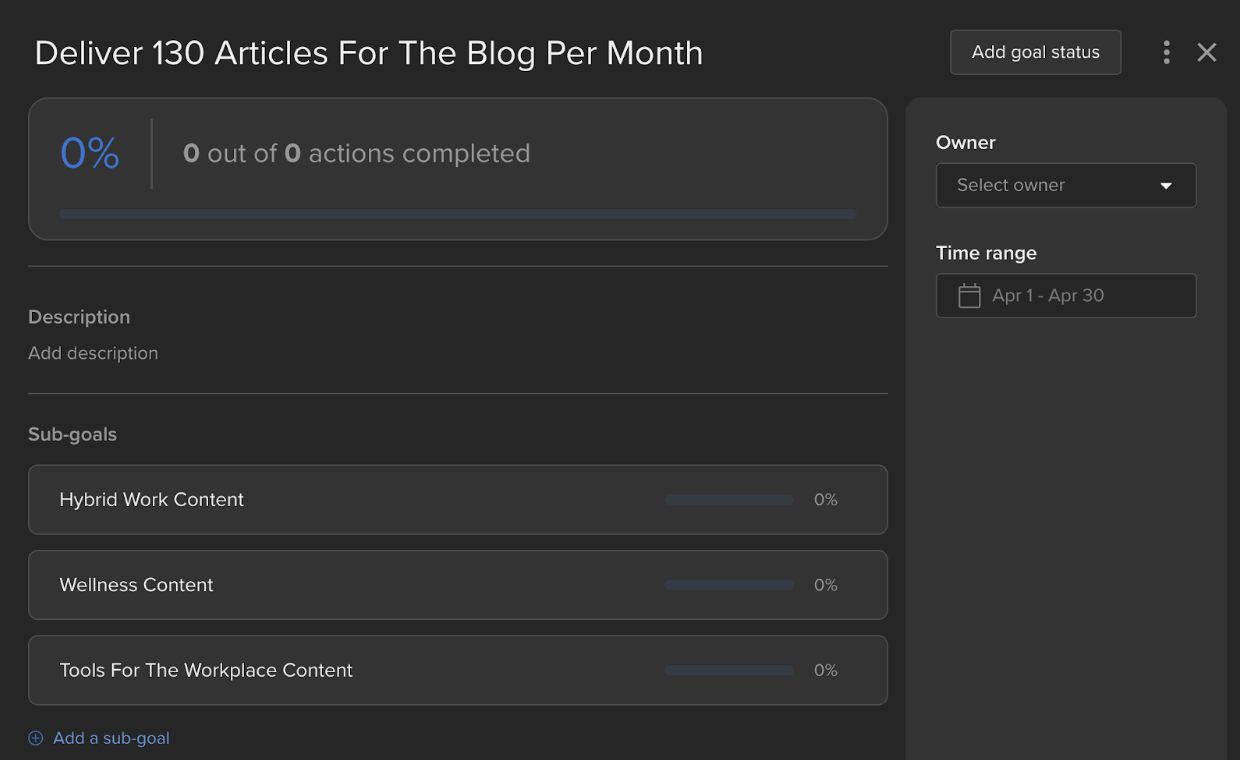
Next, Melanie had to figure out how she’d track goal measurement.
Goal Measurement: One of the ways that Melanie can track her goal measurement by completed actions within the three subgoals. This system is called ‘Task-Based Goals,’ and will help her monitor progress by tasks completed, shown in percentages.
Each piece of content will be turned into an Action Card, synced to each subgoal (which is also an individual content category.) For example, her first piece of content would live under the Hybrid Work sub-goal and is titled: ‘How To Navigate Hybrid Work in 2023.’

When a user clicks on the sub-goal, they’ll be taken to the Action Card corresponding to the piece of content. On this Action Card, Melanie also created subactions — steps needed to complete the entire task — to direct her team members to what they were responsible for. That way, everyone is on the same page about what they should be working on each week.

Over time, as the Action Cards are completed, the Parent Goal of releasing 130 articles per month will be completed.


2. Team up with other content outlets

Another component Melanie and her content team have identified as critical to their overall goal is syndication. Syndication is the process of taking content from other outlets and redistributing it on your own site — but you need their permission of course. This means establishing partnerships.
For the purposes of growing their syndicated content partnerships in 2023, she wanted to set a goal that her team could strive for each quarter that felt attainable.
Goal: Develop 10 new syndication partnerships quarterly in 2023

To measure the completion of this goal over time, Melanie decided to utilize Numerical Goals: this allows teams to set a number-based goal to measure progress. First, you Input an initial value, goal value, and current value to display your progress in a bar format or current value.
Goal measurement: For this goal, after every new agreement for syndication is signed with a content outlet, the syndication manager on the content team will manually update the parent goal through a value-based goal of 10 per quarter.
Once all 10 partnerships are logged, the goal will be marked off as complete.
3. Make sure the website is updated with all new product features and webinars

Finally, Melanie needed to use Hive’s Goals feature to tackle the biggest and most important goal of all for her content team: website and webinar updates. Being a tech start-up, Melanie’s organization is constantly adding new features to its tech tools and has to update existing customers accordingly, along with potential customers in the pipeline. With that in mind, Melanie created a parent goal.
Goal: Successfully update customers on new features, with landing pages and increase the number of webinars to 4 per month, when a new feature is released.
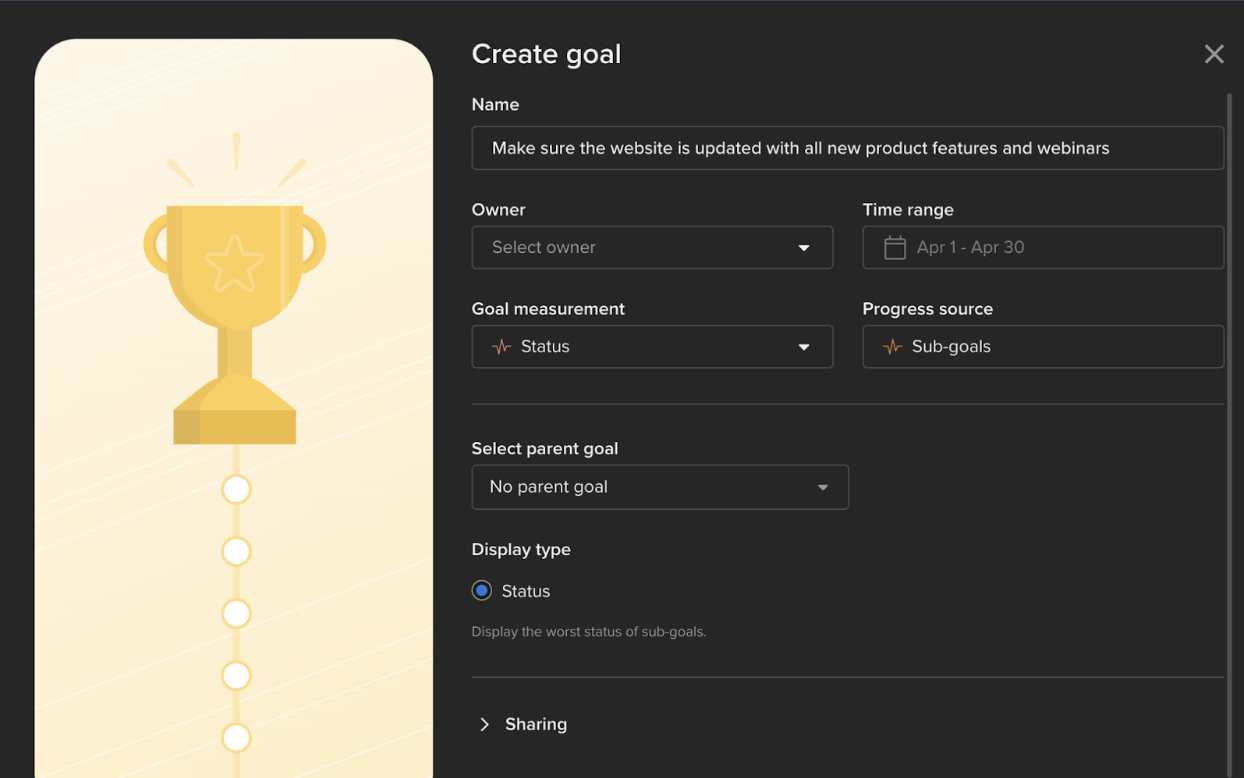
To accomplish this, Melanie knew it would be a big project, involving everyone on the content team. And there are certainly a lot of different hands at play for this specific goal. First, she had to define her team’s individual roles to understand what each person would be responsible for. Then, she had to break down each role into its own sub-goal, where that team member could then see every component they are responsible for.
For example, her team would include:
- A product marketing manager: Responsible for the set-up and delivery of content for four webinars a month
- Content creator: Responsible for creating content for landing pages and webinars
- Email marketing manager: Responsible for communicating via email about webinars and new features
- Social media manager: Responsible for sending social media blasts about new features and webinars
Melanie’s content team is even bigger than this — and to accomplish the parent goal, everyone needs to pitch in and their goals need to be tracked. In order to measure that the larger goal is being met, Melanie informed each team member about their specific sub-goal that then included their responsibilities broken down. Over time, each person can check off what work they do to meet the goal.
Goal measurement: Track the status of subgoals based on the team role
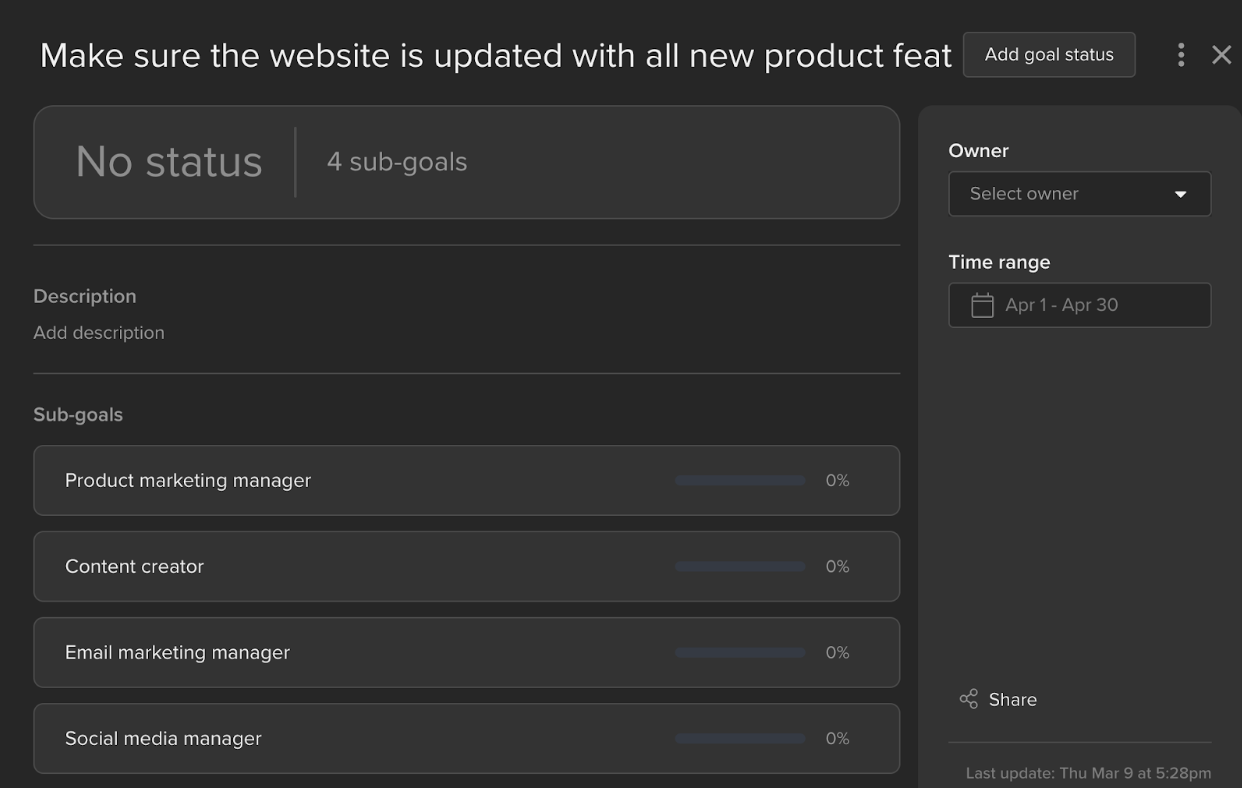

Again, using Task-Based Goals, Melanie was able to set a benchmark based on the number of tasks completed in each subgoal. Over time, it documents progress by percentage completed. Each person on the team can click into their sub-goal and track their progress through the completion of each task, such as an Action Cards.
For example, if Melanie’s product marketing manager needs to deliver on this overall goal, his Action Card might look something like this:
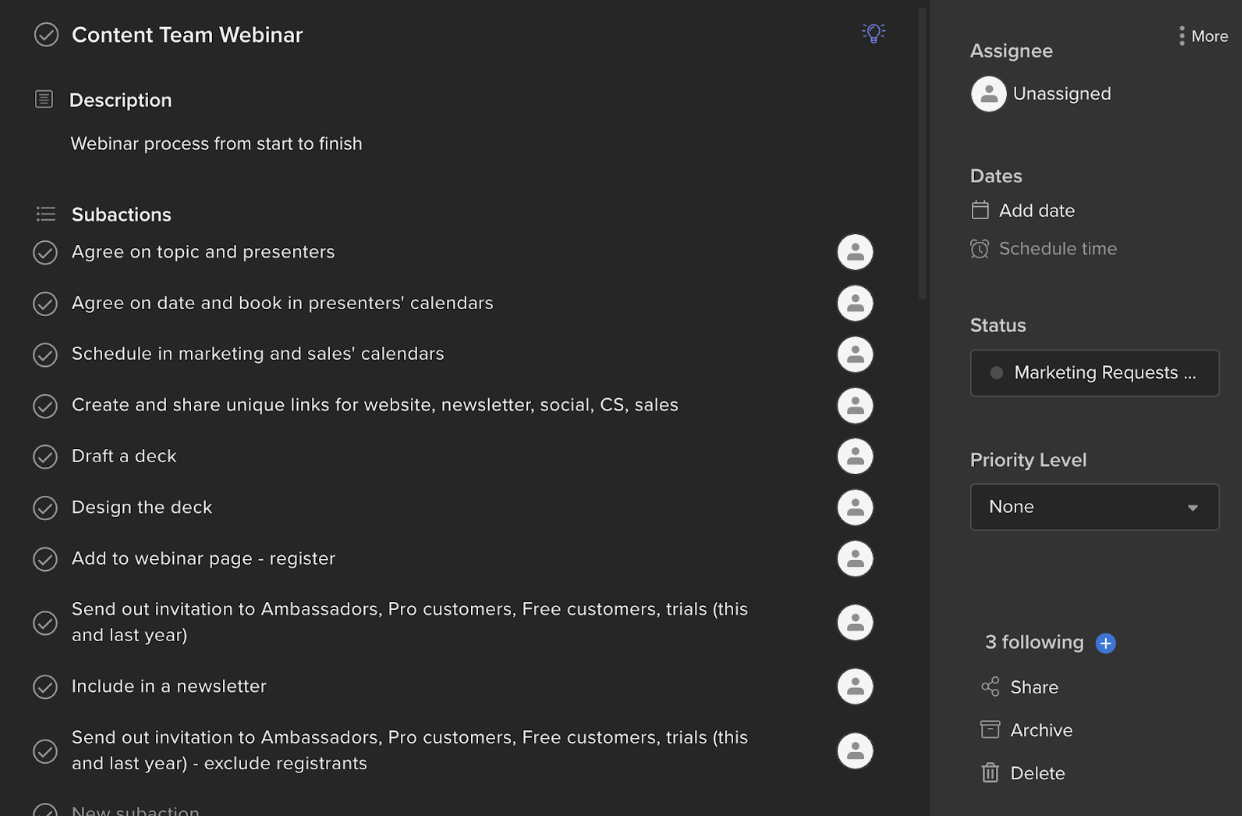
After each is checked off, Melanie (and everyone on her team) can see a birds-eye view of progress over time.
You can use Hive Goals for your content goals, too
By using Hive Goals, Melanie’s team can truly focus on what matters most: all things content! And by breaking down their biggest goals into smaller ones, her team is sure to thrive. Her team was able to accomplish:
- Produce 130 articles per month on their company blog featuring productivity tips
- Develop 10 new syndication partnerships quarterly in 2023
- Successfully update customers on new features, with landing pages and increase the number of webinars to 4 per month, when a new feature is released.
Over time, as each of these goals is completed both monthly and quarterly, the content team will see great success by the end of 2023. Using Goals is not only a tremendous way for Melanie (and any team) a way to easily set goals and track success but also shows leaders who is working hard as they progress toward their personal and team goals (maybe they deserve a shoutout in the next team meeting.)
And Goals isn’t just great for Melanie’s team. It can be an immense help to your content team, too. Everyone wants to know how they’re moving their organization forward, and we know that your content team is more than just a project. With Goals, you can set various content goals, visualize your progress, and keep everyone aligned in one centralized dashboard. You can also:
- Create one, ten, twenty, or more goals for your team, so everyone understands what they’re contributing to.
- Centralize and automate your goal tracking and reporting.
- Pull data from other systems into Hive to streamline operations and reporting.
- Share your goal or goals, assign the goal to relevant teammates, track activity, and give yourselves a deadline.
- Understand how your team and organization are pacing towards an individual goal or a set of goals.
- Color-coded designations allow an easy understanding of “on-track” items.
- When it’s time to review progress, accomplishments, and achievements, easily export all relevant information.
What are you waiting for? Up your content game now – get started for free, today!

